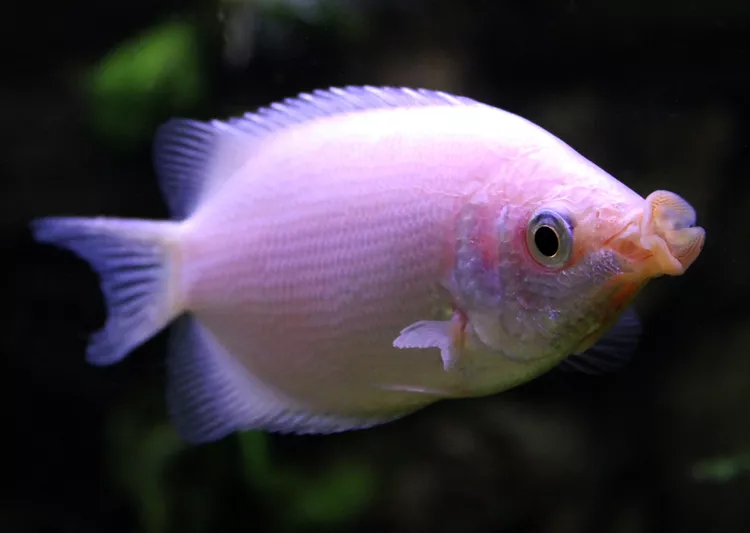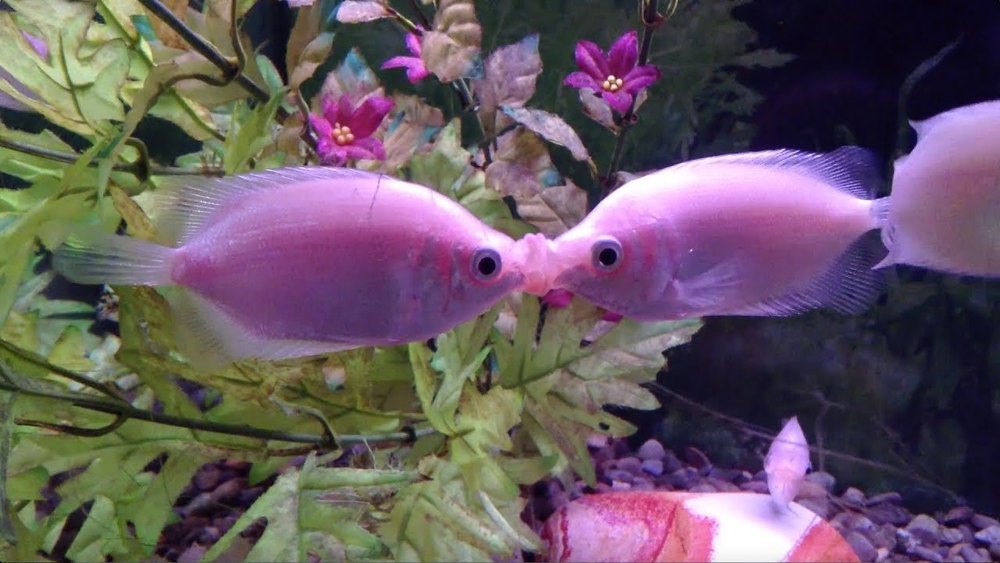Kissing Gourami
Primarily loved for its unique appearance, the Kissing Gourami, also known to many as the kissing fish, boasts of memorable thick lips and a distinctive pink coloration. This fish belongs to a one-of-a-kind genus – Helostoma temminkii, and is a favorite among seasoned fish hobbyists.
While these pink cuties are not overly demanding, it stands that understanding their temperament and needs is key to their successful keeping. This guide provides you with a comprehensive rundown of all you need to know about taking care of the Pink Gourami, such as tank partners, diet, breeding, and the suitable water conditions.
- Experience Level: Beginner
- Hardiness: Hardy
- Minimum Tank Size: 75 gal (280L)
- Maximum Size: 15 inches (40 cm)
- Temperament: Semi Agressive (territorial)
- Temperature: 72 – 82° F (22 – 28° C)
- pH Range: 6 – 8
- Water Hardness: 5 – 20dGH
- Diet: Omnivore
Table of Contents
Introduction
Size and Appearance
Care Guide
Tank Mates
Diet and Feeding
Breeding
Geographically, the Kissers’ natural habitat stretches from the Indonesian island of Java to several other Southeast Asian countries like Thailand, Sumatra, Borneo, Cambodia, Malaysia, and Vietnam.
Pink Kissing fish are denizens of still waters, dwelling primarily in swamps, lakes, canals, and ponds. These creatures inhabit waters laden with dissolved minerals owing to abundant vegetation and can survive in acidic pH levels as low as 3.0 to 4.0.
The Pink Gourami is an adaptable fish, accustomed to a wide range of water conditions due to the seasonal changes they experience in their natural habitat. Local communities value the Kissing Gourami as an applicable food source, leading to its cultivation in the southern Indochina region.
Size and Appearance
The Kissing Gourami’s most distinctive feature is its out-facing mouth – a deviation from the upward or forward-facing mouths common with many fish. The protruding mouth gives this fish its trademark “puckering for a kiss” appearance. They possess a supplementary joint that enables them to open their mouths wide, which aids in feeding on algae, aquatic plants, plankton, and insects in their original habitat.
The Kissing gourami sports a tall, slender, deep body, along with long, stretching anal and dorsal fins that consist of spinous rays. Furthermore, they also possess sublime coloration that ranges from silvery green to an appealing silvery pink color due to a genetic mutation.
In terms of lifespan, the Kissing Gourami can live up to seven years in an aquarium and up to 25 years under optimal conditions and adequate care.
Size Considerations
While pink kissers can grow up to a foot or more in the wild, they remain approximately six inches long in captivity, although with excellent care, can reach around 15 inches. That being said, even the smallest of the bunch can outgrow a 30-gallon tank. Their active nature and tank requirements make them ill-suited for mini-tanks.
Care Guide
- Minimum Tank Size: 75 gal (280 L)
- pH Range: 6 – 8
- Water Hardness: 5 – 20 dGH
- Temperature: 78 – 85° F (25.6 – 29.4° C)
- Lighting: Moderate, diffused lighting
- Substrate: Fine sand/soft substrate
- Brackish: No
- Water Flow: Weak/Low
- Tank Region: All areas
Contrary to their name, Kissing Gouramis are not romantics. The famous “kissing” behavior seen in this species is a sign of aggression, most often seen when two males contend for territory. As they mature, the frequency of territorial squabbles tends to decrease.
On rare occasions, Pink kissing gouramis can exhibit aggression towards their co-inhabitants, which might necessitate their separation. But don’t let this deter you from adding this beautiful species to your aquarium. More often than not, Kissing gouramis peacefully inhabit the middle and upper levels of the aquarium.
A 50-gallon tank would be an ideal home for your Kissing Gourami, though a roomier 75-gallon tank would be even better. Considering their active nature and semi-aggressive tendencies, a larger tank diminishes chances of territorial fights, especially if you plan to keep a group of these fish.
To replicate their natural Southeast Asian environment characterized by slow-moving waters and plentiful vegetation, use a soft substrate to cushion the tank’s bottom layer. It’s also important to keep the water temperature in the 72-82 F range, with a pH between 6.0 and 8.0, and a hardness level within 5 to 20 dGH.
Furthermore, your tank should have a good mixture of stones and plants to provide adequate hiding places as well as an open space for swimming. But do remember to leave a couple of inches of space from the top as they need access to the air due to their labyrinth organ. Apart from this, a filter and a heater are all the equipment required for a Kissing Gourami tank.
Tank Mates
Choosing the right tank partners that can tolerate the semi-aggressive nature of the Kissing Gourami is vital. Ideal companions include:
- Rosy Barbs
- Pictus Catfish
- Yoyo Loaches
- Clown Loaches
- Angel Fish
- Swordtails
- Chinese Algae Eaters
- Tiger Barbs
- Congo Tetra
- Archerfish
Feeding Guide
- Diet: Omnivore
- Frequency: Several small feedings per day
- Pellet Foods: Yes
- Flake Foods: Yes
- Live Foods: Yes
- Meat Foods: Yes
- Vegetable Foods: Yes, will often take partly cooked, dark leafy greens
Feeding a Kissing Gourami isn’t a complicated task. Being omnivores, they can eat both plants and meat. A balanced diet comprising live and frozen foods, as well as fresh vegetables like peas, cooked zucchini, and fresh romaine lettuce, is ideal for the fish’s well-being.
Breeding
Breeding this species is quite straightforward as they form pairs. The initial step involves setting up a breeding tank with warm, soft water and providing them with adequate live food. It’s not uncommon to see males circling the females, engaging in a pre-spawning dance that eventually leads to egg release and fertilization.
After the eggs are laid, carefully remove the adults to protect the eggs from being eaten, which will hatch within a day. After using up their yolk sac, fry can then be fed newly hatched brine shrimp and finely-powdered foods.



